Celebrating 120 Year Anniversary
Modernisation and Technology
In today's digital age, the role of lighthouses has transformed significantly, incorporating advanced technologies while retaining their traditional functions. The lighthouse features Automatic Identification System (AIS), which provides real-time data about the lighthouse to nearby vessels. This information enhances the safety of maritime traffic around the rock station.
Fastnet is part of a select group of lighthouses and buoys equipped with meteorological and oceanographic (MetOcean) sensors that transmit their data to Irish Lights HQ. Currently, several buoys and lighthouses are collecting weather and sea state data, including measurements of average wind speed, wind gust speed, average wind direction, gust direction, wave height, wave period, and water temperature. These values are posted on X (formerly Twitter) every 30 minutes. Follow @FastnetLHouse for updates.
Integration with Navigation Systems
Fastnet Lighthouse serves as a physical Aid to Navigation (AtoN), a critical component in the broader network of aids to navigation that include radar beacons (RACON), and satellite-based systems, such as GPS. Mariners rely on these integrated systems to plot safe courses, with Fastnet serving as a visual confirmation of electronic data. This redundancy is vital, particularly in areas where electronic systems might fail or be less reliable due to environmental factors.
Maintenance and Operations
At Fastnet, the Irish Lights team, comprising a multidisciplinary team of mechanical, electrical and electronic technicians along with the lighthouse attendant visit the station every year to carry out a range of routine and planned maintenance tasks. Other planned work such as civil repairs, are carried out as required. For significant jobs, where multiple lifts are necessary, the ILV Granuaile and a helicopter are deployed to facilitate efficient delivery of equipment and personnel to the station. During these works, the team can stay at Fastnet for up to three weeks at a time, ensuring that all tasks are completed to the highest standards without interruptions.
Recent images captured by the team highlight the seamless coordination between the ILV Granuaile, a multi-functional vessel, and helicopter operations. These efforts ensure that both capital and maintenance works are carried out efficiently, keeping the lighthouse in optimal condition.
In an era dominated by advanced satellite technology and digital navigation systems, lighthouses like the Fastnet also serve as crucial Aids to Navigation. The coastal area surrounding Fastnet is infamous for its severe weather conditions, including dense fog, heavy rains and turbulent seas. Even in a time of electronic charts and modern navigation systems, the lighthouse provides a tangible unmistakeable point of reference that help mariners safely navigate these waters. The psychological impact of a lighthouse like Fastnet cannot be understated, the sight of the light provided by this aid to navigation provides a sense of security and reassurance, especially during long voyages or in adverse conditions.
Beyond its navigational significance, it represents a rich maritime heritage and serves as a historical monument that connects the present with Ireland’s seafaring past. It is crucial for preserving maritime history and educating future generations about the evolution and importance of maritime navigation.
The Fastnet Yacht Race, a world-famous yacht race, utilises the physical Aid to Navigation of the Fastnet Lighthouse as a crucial turning point. This iconic race is widely recognised in the sailing community and is detailed on its official website. Irish Lights looks forward to collaboration with the Royal Ocean Racing Club for the centenary of the race in 2025.
Additionally, the area offshore on the south coast of Ireland, where the lighthouse is located, is designated as FASTNET in the UK Met Office sea area weather forecast broadcasts, highlighting its significance in maritime navigation and weather reporting.
https://www.metoffice.gov.uk/weather/specialist-forecasts/coast-and-sea/shipping-forecast
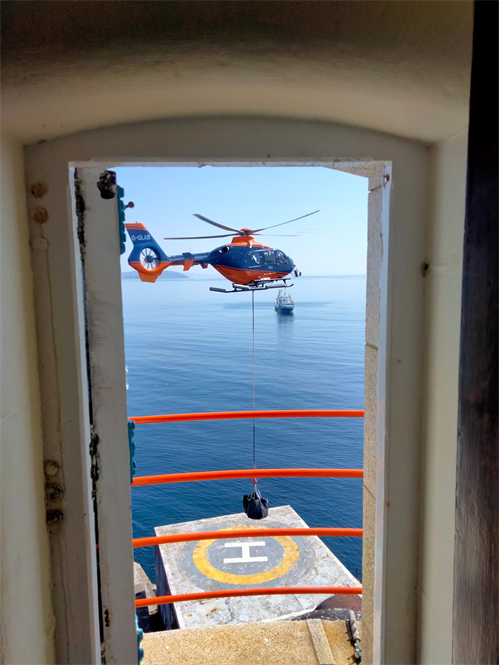
A recent image taken by the Irish Lights team at Fastnet illustrates how ILV Granuaile and helicopter operations work seamlessly together to ensure both capital and maintenance works are completed
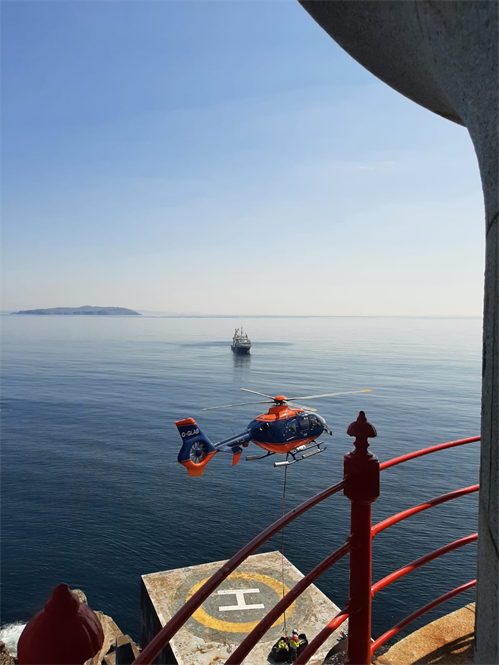
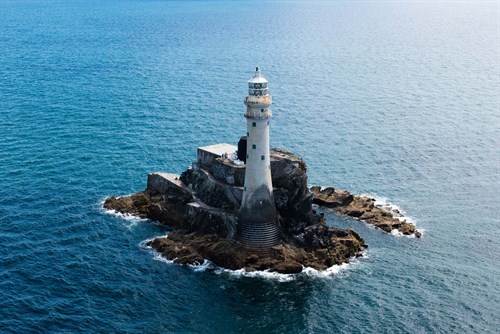
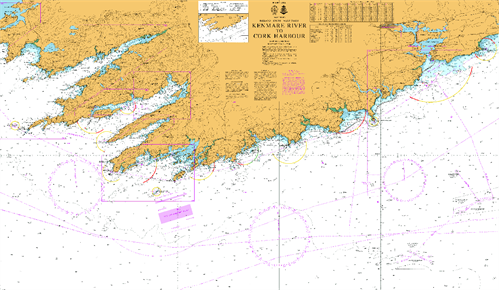
© British Crown Copyright and/or database rights. Reproduced by permission of The Keeper of Public Records and the UK Hydrographic Office (www.gov.uk/ukho). Admiralty Chart 2424: Kenmare River to Cork Harbour
Early Foundations and Construction
The story of the Fastnet Lighthouse begins in the mid-19th century, set against the backdrop of Ireland's treacherous southwestern maritime routes. The initial lighthouse, a cast-iron structure, was the brainchild of George Halpin, the esteemed Engineer to the Commissioners of Irish Lights. Completed in 1853, Halpin's design marked a significant advancement in lighthouse technology of the period.
On January 1, 1854, the new light was officially established, guiding mariners through the waters around Fastnet Rock. Despite its robust construction, the lighthouse faced immense challenges due to the harsh Atlantic conditions. Halpin's tower initially held firm, but the relentless forces of nature soon exposed its vulnerabilities.
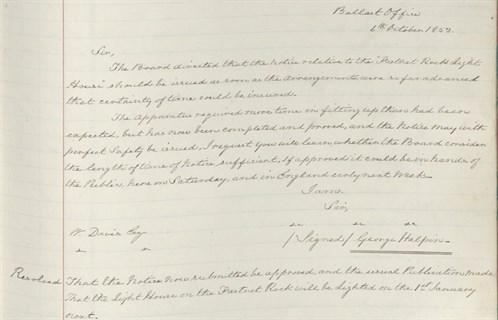
Board Collection
B/1/14/6- Lighthouse Journal No. 14, Feb 1853- Nov 1854 (Notice of Lighting; Inspector's report and description of Lighthouse on completion)
Challenges
By 1868, to bolster the lighthouse's resilience, an external cast-iron casing was added around the original tower. However, in October 1881, a storm destroyed the lighthouse, snapping off the upper portion of the structure. Remarkably, there were no casualties, but the event underscored the need for a more durable solution.
An event at Calf Rock, where a similar cast-iron lighthouse was destroyed, prompted Irish Lights to re-evaluate Fastnet's structure. Recognising the rock's critical navigational importance and the absence of the existing light, plans for a more formidable replacement were set in motion.
The Granite Tower A New Era
By 1891, approval was granted to replace the cast-iron tower with a more resilient granite structure. The task of designing this new lighthouse fell to William Douglass, an accomplished engineer with the Commissioners of Irish Lights. Construction began in earnest in 1896, employing Cornish granite, renowned for its durability. The work was a formidable feat of engineering, taking five years to complete under the supervision of Douglass and, following his health-related retirement, his successor Charles William Scott.
The new lighthouse featured a biform four-sided lens, utilising a mercury float to enhance the rotation of the light. This advanced optic system, coupled with two incandescent petroleum burners, significantly improved the lighthouse's visibility and reliability. On June 27, 1904, the new light was officially exhibited, marking the end of the temporary light and ushering in a new era of maritime safety.
Technological Advancements
Throughout the 20th century, the Fastnet Lighthouse continued to evolve with advancements in technology. Between 1910 and 1913, submarine bells were installed to further aid navigation. The light source transitioned from vaporised paraffin to electric on May 10, 1969, enhancing efficiency and brightness.
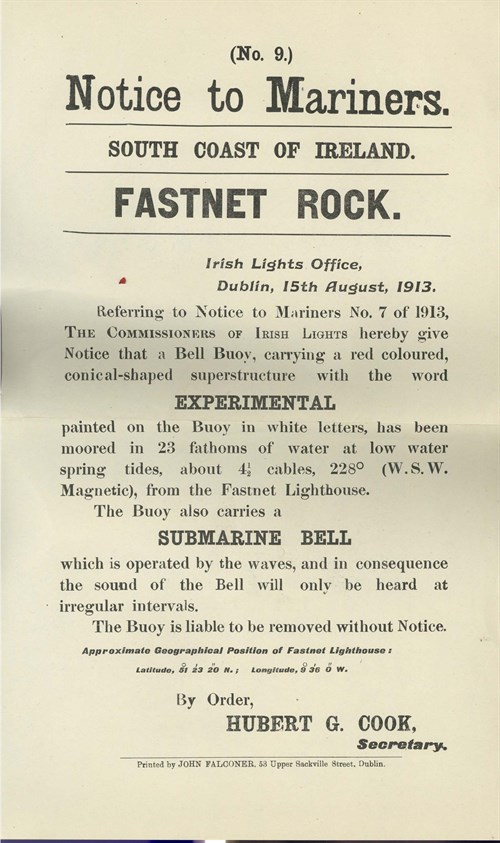
Minute Papers Collection
MP/1/3/287 (1909-1914)
The fog signal, initially an explosive type established in 1887 and transferred to the new tower in 1904, was modernised to an electric horn in 1974. By 5th April 1989, the lighthouse was automated, eliminating the need for a constant human presence. A racon was added in 1994, further enhancing its capabilities as an aid to navigation.
Commemorating Milestones
The year 2024 marks significant anniversaries for the Fastnet Lighthouse: 170 years since the original structure was established and 120 years since the current granite tower began its steadfast watch over the Atlantic. These milestones serve as a testament to the enduring importance of Fastnet as a beacon of safety and a symbol of engineering excellence.
Legacy of the Engineers and Architects
George Halpin (1779-1854), the original designer of Fastnet Lighthouse, left an indelible mark on maritime safety around Ireland. As Inspector of Works and Lighthouses for the Ballast Board, his career was dedicated to enhancing aids to navigation across the coastline. His legacy continued through his son and other protégés who followed in his footsteps.
William Douglass (1831-1923), an English-born lighthouse engineer, brought a wealth of experience and innovation to the construction of the granite tower. His tenure with the Commissioners of Irish Lights saw significant improvements in lighthouse design, ensuring safer seas for countless mariners.
Charles William Scott (Engineer to Irish Lights 1900-1930), Douglass’s successor, completed the construction of the new Fastnet Lighthouse and continued to innovate in the field. His contributions were vital in maintaining and advancing the lighthouse's technological capabilities well into the 20th century.
The Fastnet Lighthouse stands not only as a crucial aid to navigation but also as a testament to innovation, enduring legacy, and human ingenuity.
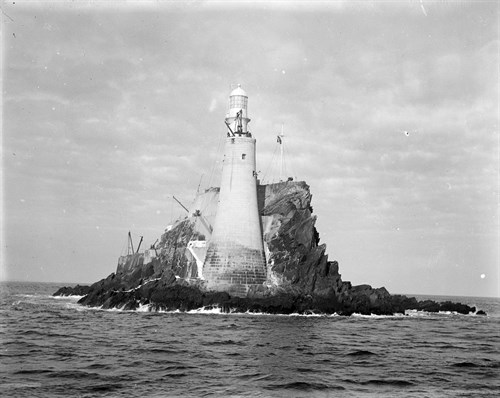
Commissioners of Irish Lights/ NLI


